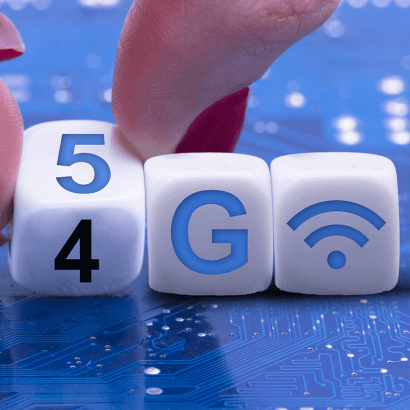5G vs 4G: What’s the difference?

Fifth-generation networking is finally here. Promising superfast speeds, the technology is expected to revolutionise mobile networking, but how exactly will it do this compared to 4G?
Though challenges persist for deployment globally, mobile network operators and technology providers are optimistic as ever for the future of 5G. The 2021 Ericsson Mobility Report predicts 5G will account for nearly half of all mobile subscriptions by 2027, when they are expected to reach 4.4 billion.
What is 5G?
5G is a new digital system for transforming bytes - data units - over air. It uses a 5G New Radio interface, along with other new technologies, that utilises much higher radio frequencies (28 ghz compared to 700 mhz - 2500 mhz for 4G) to transfer exponentially more data over the air for faster speeds, reduced congestion and lower latency.
This new interface, which uses millimetre wave spectrum, enables more devices to be used within the same geographic area; 4G can support about 4,000 devices per square kilometre, whereas 5G will support around one million. This means more Netflix streaming, voice calls and YouTube carried, without interruption, over the limited air space.
5G also uses a new digital technology called Massive MIMO, which stands for Multiple Input Multiple Output, that uses multiple targeted beams to spotlight and follow users around a cell site, improving coverage, speed and capacity. Current network technologies operate like floodlights, illuminating an area but with lots of wastage of the light/signal. Part of the roll-out of 5G involves installing Massive MIMO and 5G New Radio to all mobile network base stations on top of the existing 4G infrastructure.
How is 5G different from 4G?
Compared to third generation mobile networking, 4G enabled previously impossible quality video streaming and calling on the go. More video streaming, however, has increased congestion in the network.
A major difference between 5G and 4G is that this congestion will be eliminated. But arguably, 5G’s biggest differentiator to 4G will be as a gateway for the Internet of Things-connected world at scale. Later iterations of 5G networking are expected to be revolutionary for data-driven industries, smart cities and infrastructure management because it will be possible to have many more devices working, reliably, securely and uninterrupted in the same area.
Overall, due to the new technologies, spectrum and frequencies it uses, 5G has several benefits over 4G:
- higher speeds,
- less latency,
- capacity for a larger number of connected devices,
- less interference and
- better efficiency.
How does 5G actually work?
Each operator owns blocks of spectrum which is a range of electromagnetic radio frequencies used to transmit sound, data, and video across a country. This spectrum is added together to create their total network capacity which determines how fast they can transfer data.
Latency for 4G is around 20-30 milliseconds, but for 5G it will reach well below 10 milliseconds, and in best cases around 1 millisecond delays.
How fast is 5G compared with 4G?
5G promises device speeds around 10 times faster than 4G, meaning high-quality, ultra-high resolution 4K video calls downloads will be delivered even quicker to smartphones and tablets. Data transfer of less than 20 milliseconds will be standard.

 Blog
Blog
Leave a Comment